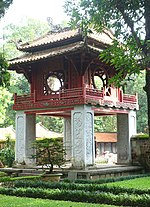Cửa Bắc Church
| Cửa Bắc Church | |
|---|---|
| Church of Our Lady of Hà Nội | |
 The church was restored to its original yellow paint in 2013 | |
 | |
| 21°02′29″N 105°50′27″E / 21.041368°N 105.840708°E | |
| Location | Hanoi |
| Country | Vietnam |
| Denomination | Catholic Church |
| Website | https://cuabacchurch.com/ |
| History | |
| Former name(s) | Église des Martyrs (Church of Martyrs) |
| Authorising papal bull | 1932 |
| Architecture | |
| Architect(s) | Ernest Hébrard |
| Style | Indochinoise, Baroque |
Cửa Bắc Church ("Church at Northern gate", Vietnamese: Nhà thờ Cửa Bắc) is a Roman Catholic church in Hanoi, Vietnam. Originally named as Church of Martyrs' Lady (Vietnamese: Nhà thờ Nữ Vương Các Thánh Tử Đạo), the church was built in 1932 by the French administration of Indochina as a part of the Hanoi's urban plan supervised by Ernest Hébrard. Today, Cua Bac Church is one of the three major churches of Hanoi, together with Ham Long Church and Saint Joseph Cathedral. In November, 2006, the Cua Bac Catholic Church became the venue of joint worship service of the Vietnamese Catholics and Protestants with participation of the United States President George W. Bush, who was on an official visit to Vietnam.
History[]


In the early 1920s, the French architect Ernest Hébrard began his urban plan to redesign the city of Hanoi, as a part of this plan, a new Roman Catholic church named Church of Martyrs was built in front of the Northern Gate (Cửa Bắc) of the ancient Hanoi Citadel in 1932.[1] Because of its location, the church was more commonly known as Cua Bac Church. Ernest Hébrard designed Cua Bac Church in eclectic style with strong influence of Art Deco decoration,[2] he also integrated in the Catholic Church some elements of the traditional architecture in Vietnam such as the system of roof tiles and the harmony between the main architecture with its surrounding green space. For that reason, Cua Bac Church is considered a fine example for the mixed style between European and Vietnamese architectures.
Originally planned to be named Vietnamese Martyrs, the title of the church was changed to Queen of Martyrs because at that time, the Vietnamese Martyrs was not yet canonized. In 1959, the Apostolic Vicar Joseph-Marie Trịnh Như Khuê re-titled it as the Church of Our Lady of Hanoi. The feast day of the church's title is July 2, the old date for Visitation.
Today, Cua Bac Church is one of the three major churches of Hanoi, together with Ham Long Church and Saint Joseph Cathedral.[3] In November 2006, Cua Bac Church was chosen the venue of a joint congregation of the Vietnamese Catholics and Protestants with participation of the United States President George W. Bush, who was on an official visit to Vietnam.[4][5] After the service, the President remarked: "Laura and I just had a moment to converse with God in a church here in Hanoi. We were touched by the simplicity and the beauty of the moment. We appreciate very much the congregation for allowing us to come and worship with them."[6]
References[]
- ^ Guillaume, Xavier. La Terre du Dragon Tome 1 (in French). Editions Publibook. p. 240. ISBN 2-7483-2450-1.
- ^ Logan, William Stewart (2000). Hanoi: biography of a city. UNSW Press. p. 101. ISBN 0-86840-443-8.
- ^ "Hanoi and its churches sparkle splendidly for Christmas". Vietnamnet.vn. 2009-12-24. Missing or empty
|url=(help) - ^ McGeown, Kate (2006-11-19). "Bush's church visit rewards Vietnam". BBC.
- ^ "US President to pay longest visit to Vietnam". Vietnamnet.vn. 2006-11-06. Missing or empty
|url=(help) - ^ "President Bush Attends Church Service in Vietnam". Georgewbush-whitehouse.archives.gov. 2006-11-19.
- Roman Catholic churches in Hanoi
- Roman Catholic churches completed in 1932
- 20th-century Roman Catholic church buildings in Vietnam


